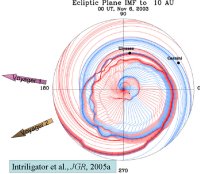Ulysses Plays Central Role in Heliospheric Network Workshop
15 November 2006
More than 80 scientists from Europe and the US gathered in Oxnard, California, at the beginning of November to pore over the latest results from the Heliospheric Network, the international fleet of spacecraft studying the Sun and heliosphere, and to discuss its future. A key member of the Network is the joint ESA-NASA mission Ulysses, soon to embark on its third passage over the Sun's poles. Together with SOHO and NASA's ACE, Voyager and Wind spacecraft, Ulysses is exploring the influence of the Sun on our deep space environment from the unique out-of-ecliptic orbit that takes it over the Sun's polar regions every 6.2 years.The four themes of the Workshop were
- The Outer Heliosphere and Interstellar Connection
- Solar Wind Transients
- Energetic Particles
- Solar Cycle Variations
With its comprehensive data set already covering almost a full 22-year magnetic cycle of the Sun, Ulysses plays a central role in all of these areas. Measurements from Ulysses encompass the heliospheric magnetic field, the bulk properties of the solar wind as well as its composition, energetic charged particles and cosmic rays, natural radio emission, cosmic dust, neutral interstellar helium, and gamma ray bursts. These data are being used to study physical processes in the heliosphere ranging in distance from the solar surface to the local interstellar cloud, and in time from the present to the earliest moments of the universe.
 |
|
Computer simulation of a solar wind disturbance triggered by a solar storm as it moves through the heliosphere past members of the Heliospheric Network. |
In addition to reviewing recent results from the Heliospheric Network, Workshop participants discussed in detail the future opportunities for break-through science using the Network. An important element in these deliberations was the arrival of two "new kids on the block", the twin STEREO spacecraft launched by NASA at the end of October. A number of very interesting constellations involving Ulysses, STEREO, ACE and Wind occur in 2007 and 2008 as Ulysses makes its third pole-to-pole transit. "With all these exciting scientific opportunities ahead, it's unfortunate that Ulysses may no longer be part of the Network after March 2008", says Marsden, referring to the current plan to end the mission at that time.
Contact
Dr. Richard Marsden
ESA - Ulysses Project Scientist
Email: Richard.Marsden esa.int
esa.int

